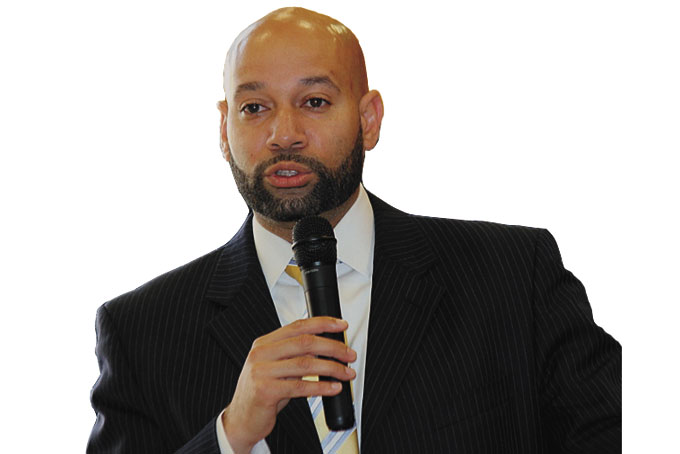
COMMUNITY DEVELOPMENT—Councilman R. Daniel Lavelle spoke to Hill District residents at a recent meeting.
The last time the lower Hill District underwent massive redevelopment, it forever changed the Hill District. That’s why District 6 City Councilman Daniel Lavelle, and community leader Marimba Milliones are working to engage Hill District residents in the planning process for the former Civic Arena site once connected to their neighborhood.
“Your opinions, thoughts, and concerns are critical and we don’t want to push forward without your input,” said Lavelle at a community meeting on Sept. 24.
“We don’t want to build something there that has a negative impact here,” said Milliones, president of the Hill Community Development Corporation.”
The community meeting provided the public with an update on plans for the 28-acre former Civic Arena site and negotiations with the Pittsburgh Penguins. The Lower Hill Working Group, which has been tasked with developing a Community Collaboration and Implementation Plan, is asking the Penguins to sign a legally enforceable document and to be a part of future decisions.
“While we all would like to shake on a deal and have it happen, we know that’s pretty hard to carry out in the Hill District,” Milliones said. “We have some concerns with the plan they want to submit.”
The Pittsburgh Penguins recently announced they had selected St. Louis-based McCormack Baron as the site developer. The current development plan is for house and apartment rental properties and an assortment of office and retail space.
Eighty percent of the housing would be sold at market rate and 20 percent would be affordable housing. However, according to Milliones even affordable housing would cost a minimum of $800 per month because prices are based on 80 percent of the median income. The Lower Hill Working Group is asking for 30 percent affordable housing at all income levels.
“In Pittsburgh there are gaping disparities between how much Blacks earn and how much Whites earn,” Milliones said. “So not only would you have a socially segregated site, but also a racially segregated site.”
Housing was a major focus of the community meeting which also provided updates on developments in other parts of the neighborhood. According to Milliones, 53 percent of the Hill District’s 5,087 properties are vacant. This includes 2308 vacant lots and 373 vacant buildings.
In an effort to reduce vacancies, the Hill CDC will be launching the Hill District 100 initiatives with the goal of getting 100 people to purchase homes in the Hill District. Prospective homebuyers will receive help securing a mortgage and credit counseling.
“Right now the home ownership rate in the Hill District is 20 percent, which means we will have a whole bunch of problems if we don’t start focusing on home ownership,” Milliones said. “There is one way to ensure you won’t be forced out of your neighborhood and that’s if you own the land and that’s why we’re really emphasizing home ownership.”